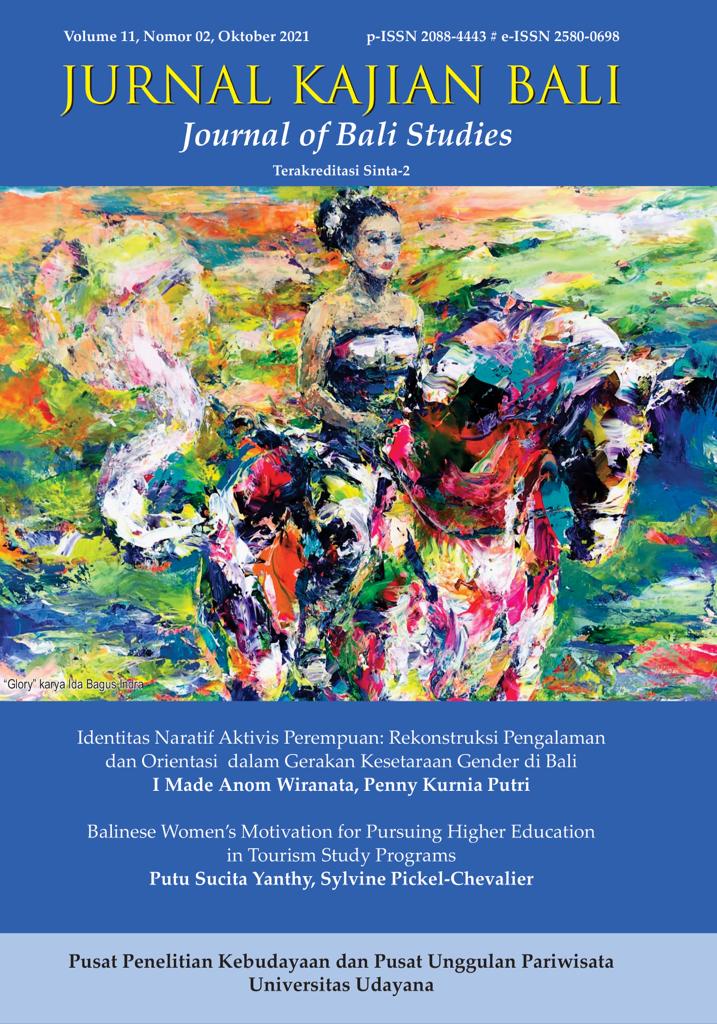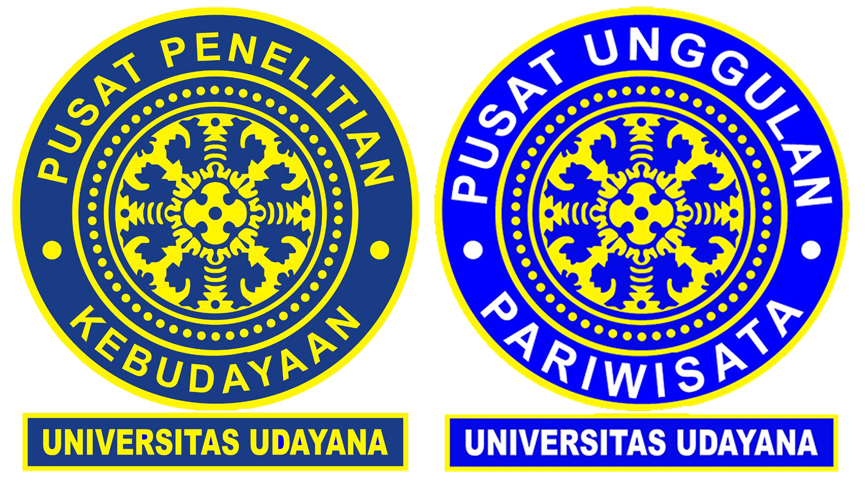The Role of Branding Strategy in Strengthening the Image of the Village Tourism in Bali
(Research Study on Village Tourism in Bali)
Abstract
The purpose of this study is to analyze how the tourism village brand strategy in Bali can strengthen the village’s image. The methods are descriptive qualitative (interviews) and quantitative (survey). Eight key informants who are involved in managing the tourism village were interviewed. The sampling technique for the survey was purposive, involving 126 tourists who have visited the tourism villages. Thematic analysis was conducted for the qualitative data; whereas, multiple linear regression was used to analysed the quantitative data. The findings are brand equity and conceptual branding strategy in tourism village have been implemented, however, they need to be optimalized to strengthen the village tourism’s image. The finding from the quantitative data shows that the brand relationship significantly strengthens the image of the tourism village. This research implies that there is a necessity for tourism villages in Bali to design and implement more specific branding methods and set specific purposes so that the new positioning will distinguish them from their competitors and hence, directly strengthen the image.
Downloads
References
Anderson, J. R. (2013) The Architecture of Cognition. New York: Psychology Press. doi: https://doi.org/10.4324/9781315799438.
Arida, I. N. S. and Pujani, L. K. (2017) ‘Kajian Penyusunan Kriteria-Kriteria Desa Wisata Sebagai Instrumen Dasar Pengembangan Desawisata’, Jurnal Analisis Pariwisata, 17(1), pp. 1–9.
Berthon, P., Pitt, L. F. and Campbell, C. (2009) ‘Does brand meaning exist in similarity or singularity?’, Journal of Business Research. Elsevier Inc., 62(3), pp. 356–361. doi: 10.1016/j.jbusres.2008.05.015.
Cai, L. A. (2002) ‘Cooperative branding for rural destinations’, Annals of Tourism Research, 29(3), pp. 720–742. doi: 10.1016/S0160-7383(01)00080-9.
Cai, L. A., Feng, R. and Breiter, D. (2004) ‘Tourist purchase decision involvement and information preferences’, Journal of Vacation Marketing, 10(2), pp. 138–148. doi: 10.1177/135676670401000204.
Chen, C. F. and Tsai, D. C. (2007) ‘How destination image and evaluative factors affect behavioral intentions?’, Tourism Management, 28(4), pp. 1115–1122. doi: 10.1016/j.tourman.2006.07.007.
Gartner, W. C. (1989) ‘Tourism image: attribute measurement of state tourism products using multidimensional scaling techniques’, Journal of Travel Research, 28(2), pp. 16–20. doi: 10.1177/004728758902800205.
Hartanto, D. and Sylvia, M. (2016) ‘Perancangan Destination Branding Desa Wisata Bermi Kabupaten Probolinggo’, Universitas Kristen Petra, 66, pp. 37–39.
Hobart, M. (2011) ‘Bali is a Brand: A Critical Approach’, Jurnal Kajian Bali (Journal of Bali Studies), 1(1), pp. 1–26.
Inskeep, E. (1991) Tourism Planning An Integrated and Sustainable Development Approach. Edited by V. N. Reinhold. New York: Wiley.
Karta, N. L. P. A. et al. (2019) ‘How Does the Shifting of Marketing Strategy in the Hospitality Industry Contribute to the Sustainability Company Growth ?’, nternational Journal of Interdisciplinary Current Advanced Research www.ijicar.in, 0931(03), pp. 41–49.
Karta, N. L. P. A., Kusumawijaya, I. K. and Kappola, V. B. (2020) ‘The Roles and Contributions of Stakeholders in Villages Tourism Brand Management in Bali and India’, Jurnal Kajian Bali, 10(23), pp. 95–118. doi: https://doi.org/10.24843/JKB.2020.v10.i01.p04.
Karyono, H. A. (1997) Kepariwisataan. Jakarta: PT. Gramedia Widiasarana, Indonesia.
Keller, K. L. (2013) Strategic Brand Management : Building, Measuring, and Managing Brand Equity. United Kingdom: Pearson.
kemenparekraf.go.id (2021) Siaran Pers : Strategi Menparekraf Dalam Percepatan Pemulihan Sektor Parekraf Tanah Air, https://kemenparekraf.go.id/. Available at: https://kemenparekraf.go.id/berita/Siaran-Pers-:--Strategi-Menparekraf-Dalam-Percepatan-Pemulihan-Sektor-Parekraf-Tanah-Air (Accessed: 14 August 2021).
Konecnik, M. and Go, F. (2008) ‘Tourism destination brand identity: The case of Slovenia’, Journal of Brand Management, 15(3), pp. 177–189. doi: 10.1057/palgrave.bm.2550114.
Kotler, P. (2016) Branding From Purpose to Benefidience, Marketing Journal.org. Available at: http://www.marketingjournal.org/brand-purpose-to-beneficence-philip-kotler/ (Accessed: 11 September 2019).
Kotler, P. et al. (2019) Principles of Marketing. United Kingdom: Pearson Edication. Available at: https://www.google.co.id/books/edition/Principles_of_Marketing/neksEAAAQBAJ?hl=en&gbpv=0.
Kotler, P. and Armstrong, G. M. (2001) Principles of Marketing. United Kingdom: Prentice Hall, 2001.
Kotler, P. and Keller, K. L. (2012) Marketing Management. Germany: Pearson Edication, 2012.
Kotler, P. and Keller, K. L. (2016) Marketing Management. Pearson, 2016.
Maharani, E. (2015) ‘Wonderful Indonesia’ Peringkat 47 Branding Terbaik di Dunia | Republika Online, https://www.republika.co.id/. Available at: https://www.republika.co.id/berita/nshofd335/wonderful-indonesia-peringkat-47-branding-terbaik-di-dunia (Accessed: 22 August 2021).
Michandani, E. S. and Arida, I. N. S. (2019) ‘Perancangan Destination Branding Desa Wisata Kerta di Kecamatan Payangan Kabupaten Gianyar’, Jurnal Destinasi Pariwisata, 7(1), p. 111. doi: 10.24843/jdepar.2019.v07.i01.p17.
Netemeyer, R. G. et al. (2004) ‘Developing and validating measures of facets of customer-based brand equity’, Journal of Business Research, 57(2), pp. 209–224. doi: 10.1016/S0148-2963(01)00303-4.
Nurlina (2017) ‘Pengaruh E-Service Quality , Dan Kepercayaan Online’, Lentera Bisnis, 6(2), pp. 83–93.
Permada, C. (2018) Pengaruh Corporate Image dan E-service quality terhadap e-satisfaction serta e-loyalty pengguna aplikasi shopee di Denpasar. Udayana. Available at: https://sukarsa.unud.ac.id/repositori/tesis?nim=1590662031.
Putri, R. A. S. I., Sinyor, E. P. and Putri, A. C. (2018) ‘Strategi Pengembangan Potensi Desa Wisata Berbasis Analisis Swot Desa Sidomekar Dan Penggunaan Aplikasi Tour Guide Online Kabupaten Jember’, Seminar Nasional Manajemen dan Bisnis ke-3. Program Studi Manajemen Fakultas Ekonomi dan Bisnis Universitas Jember, 3, pp. 173–187.
Qu, H., Kim, L. H. and Im, H. H. (2011) ‘A model of destination branding: Integrating the concepts of the branding and destination image’, Tourism Management. Elsevier Ltd, 32(3), pp. 465–476. doi: 10.1016/j.tourman.2010.03.014.
Rizan, M., Yulianti, D. and Rahmi, R. (2015) ‘the Influence of Price and Service Quality of Brand Image and Its Impact on Customer Satisfaction Gojek (Students Study on a State University of Jakarta)’, JRMSI - Jurnal Riset Manajemen Sains Indonesia, 6(2), pp. 639–658. doi: 10.21009/jrmsi.006.2.08.
Septiani, A. (2016) Pengaruh Brand Image dan E-Service Quality Terhadap Customer Satisfaction Bukalapak: (Studi Kasus Pada Pelanggan Bukalapak). Universitas Islam Negeri Syarif Hidayatulah, Jakarta. Available at: http://repository.uinjkt.ac.id/dspace/handle/123456789/33254.
sipp.menpan.go.id (2021) Alur Penetapan Desa Wisata, https://sipp.menpan.go.id/. Available at: https://sipp.menpan.go.id/pelayanan-publik/bali/kabupaten-tabanan/alur-penetapan-desa--wisata (Accessed: 19 August 2021).
Swaminathan, V., Page, K. L. and Gürhan-Canli, Z. (2007) ‘“My” brand or “our” brand: The effects of brand relationship dimensions and self-construal on brand evaluations’, Journal of Consumer Research, 34(2), pp. 248–259. doi: 10.1086/518539.
Tarigan, A. (2020) Pemerintah Fokus Pengembangan Desa Wisata dan Desa Digital | Kementerian Koordinator Bidang Pembangunan Manusia dan Kebudayaan, kemenkopmk.go.id. Available at: https://www.kemenkopmk.go.id/index.php/pemerintah-fokus-pengembangan-desa-wisata-dan-desa-digital (Accessed: 18 August 2021).
Tasci, A. D. A. and Kozak, M. (2006) ‘Destination brands vs destination images: Do we know what we mean?’, Journal of Vacation Marketing, 12(4), pp. 299–317. doi: 10.1177/1356766706067603.
Wisnawa, I. M. B. (2021) ‘Dimensi Brand Loyalty Bali sebagai Destinasi Wisata bagi Wisatawan Nusantara pada Masa Pandemi Covid-19’, Jurnal Kajian Bali (Journal of Bali Studies), 11(04), p. 29.

This work is licensed under a Creative Commons Attribution 4.0 International License.



















